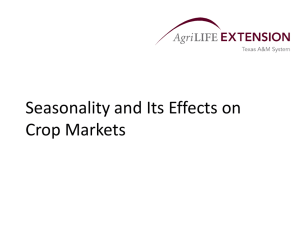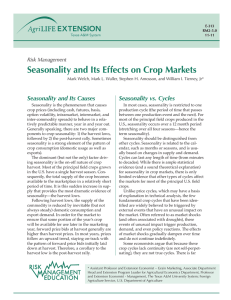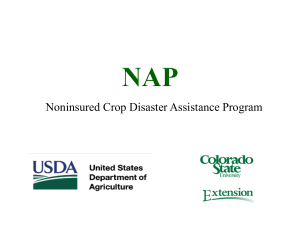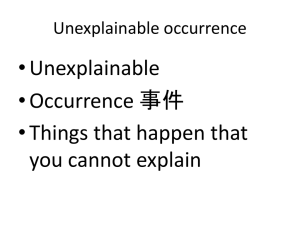Seasonality and Its Effects on Crop Markets
advertisement
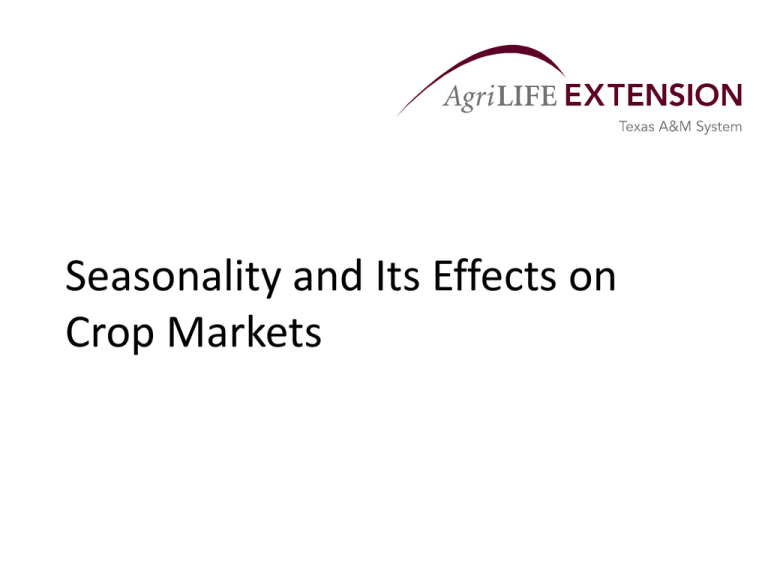
Seasonality and Its Effects on Crop Markets Seasonality and Its Causes Seasonality is the phenomenon that causes crop prices (including cash, futures, basis, option volatility, intramarket, intermarket, and inter-commodity spreads) to behave in a relatively predictable manner, year in and year out. Generally speaking, there are two major components to crop seasonality: The harvest lows, followed by The post-harvest rally Sometimes seasonality is a strong element of the pattern of crop consumption (domestic usage as well as exports). Seasonality and Its Causes cont. The dominant factor driving seasonality is the on-off nature of crop harvest. Most principal field crops grown in the U.S. have a single harvest season. Consequently, the total supply of the crop becomes available to the marketplace in a relatively short period of time. It is this sudden increase in supply that provides the most dramatic evidence of seasonality – the harvest lows. Following harvest lows, the supply of the commodity is reduced by inevitable domestic consumption and export demand. Seasonality and Its Causes cont. In order for the market to ensure that some portion of the year’s crop will be available for use later in the marketing year, forward price bids at harvest generally are higher than harvest prices. In most years, prices follow an upward trend, staying on-track with the pattern of forward price bids initially laid down at harvest. Therefore, a corollary to the harvest low is the postharvest rally. Seasonality vs. Cycles In most cases, seasonality is restricted to one production cycle (the period of time that passes between one production event and the next). For most of the principal field crops produced in the U.S., seasonality occurs over a 12 month period. Seasonality should be distinguished from other cycles. Seasonality is related to the calendar and is usually based on changes in supply and demand. Cycles can last any length of time. While there is ample statistical evidence for seasonality in crop markets, there is only limited evidence that other types of cycles affect the markets for most of the principal U.S. field crops. Seasonality vs. Cycles cont. Unlike price cycles, which may have a basis of explanation in technical analysis, the few fundamental crop cycles that have been identified are widely believed to be triggered by external events that have an unusual impact on the market. Often referred to as market shocks, these events of unusual impact trigger production, demand, and even policy reactions. The effects of market shocks gradually dampen over time and do not continue indefinitely. Some economists argue that because these crop cycles lack continuity, they are not true cycles. Seasonality vs. Trends Many other factors besides seasonal fluctuations in supply and demand affect crop prices. Price trends are the result of gradual one-directional changes in supply and demand that occur over a period of time. These trends can have a powerful influence on market prices and can significantly alter seasonal patterns. Consequently, trends and other inconsistencies can cause prices to deviate substantially from those that would be expected based on the crop’s seasonal pattern. Figure 1. Relationship Between Seasonal, Cyclical, and Trend Effects on Prices for a Hypothetical Crop Normal vs. Conditioned Seasonals The normal seasonal pattern that prevails can be estimated as the average of all years or the average of the majority of years deemed to be free of unusual market shocks. Or, a conditioned seasonal could be constructed using data from years in which a specific condition is applied. Sometimes referred to as analog modeling, it is a technique commonly used in forecasting other things besides commodity prices. In commodity analysis, it is common to separate grain seasonals into two groups: Short crop years – years in which yields fell significantly below the trend because of drought, freezes, floods, lack of growing degrees, etc. Normal years – all years other than short crop years. Normal vs. Conditioned Seasonals cont. A 1995 study of optimal corn marketing strategies found that the best marketing strategy in years following short crops was futures hedge on 100 percent of the expected production in the fourth week of February, covered by a $.20 out-of-the money call on new crop futures that was offset in the first week of July. Conversely, in years that did not follow a short crop, the best marketing strategy was to purchase a $.20 out-of-the money puts on new crop futures on 80 percent of expected production in the third week of May, hedge with futures the remaining 20 percent in the first week of July, and offset the puts in t he second week of September. Normal vs. Conditioned Seasonals cont. Another criterion commonly used to discriminate between years is to examine years when another major fundamental supply/demand factor changed. It is sometimes useful to construct a conditioned seasonal, picking, the appropriate years based not on a particular supply/demand fundamental but on an unusual price phenomenon. For example, if the December corn futures contract set a new life-of-contract low in July, is that a reliable predictor that the contract will trade lower in the succeeding months? An example of a seasonal of this type is provided in Figure 2. Figure 2. 10-year Average Wheat Price Index (20012011) and Conditional Seasonal Wheat Price Index Index 09/10 $/bushel 120 $6.00 115 $5.50 110 105 $5.00 100 $4.50 95 90 $4.00 85 80 $3.50 Jun Jul Aug Sep Oct 10-year Avg Index Nov Dec Jan Feb Conditional Index Mar Apr May 09/10 Price Normal vs. Conditioned Seasonals cont. Another method of checking for seasonal patterns is the seasonal high-low table. This method simply requires identification of the season of interest and recording the months in which the highs and lows occurred over a number of years. Table 1 provides an example of a high-low table for December corn contract. The calendar year contract highs tend to cluster in late spring to early summer with contract lows more dispersed, but generally in the second half of the year. Table 1. Month of High and Low of December Corn Contract During the January to December Period Contract Year Jan Feb Mar Apr 2000 2001 May Jun H Aug Sep Oct Nov Dec L H L 2002 L H 2003 2004 Jul L H H L 2005 H 2006 L L 2007 H 2008 H 2009 H 2010 L H L L L H Timing and Magnitude of Price Changes There are two purposes of seasonal analysis To correctly identify the timing of a season’s high and low. To estimate the magnitude of the difference between the high and low price. Sometimes market analysts rely on timing to identify the seasonal lows and then rely on magnitude to predict the high. Of the two, timing is the more important for speculative purposes, whereas magnitude is often more important for hedging purposes. Farmers may make or lose money in their commodity futures/options accounts, but the ultimate profitability of the agricultural enterprise depends on the net profit of the crops produced. It follows, therefore, that a farmer should be more interested in selling a crop at a profitable price than selling it at the seasonal high.
